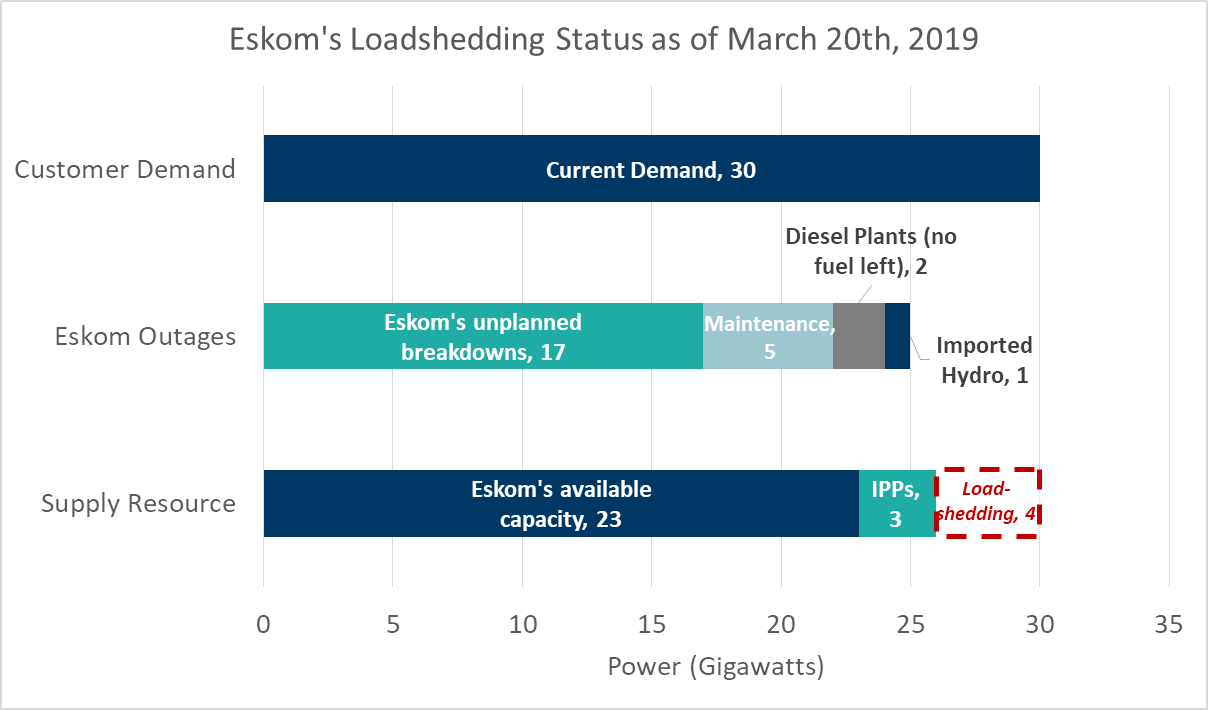
Eskom Energy Crisis & Failing Coal Plants
The Eskom energy crisis continues with regular rolling blackouts across South Africa largely due to the utility’s failing coal plants. Eskom announced Stage 4 Load Shedding during most of the business hours of last week and expects supply to remain constrained in the near-term. While unplanned breakdowns at 1/3 of its existing power plants were the major cause of Eskom’s supply shortfall last week, other events also played a role like the utilities lack of funds to buy diesel and water shortages. The damaged transmission lines from cyclone Idai in Mozambique also cut-off electricity imports and pushed Eskom over the edge into Stage 4.
Despite the utility’s installed capacity of ~48GW and current demand at just 30GW, the low availability of it’s plants suggests the country would benefit from bringing more IPPs and distributed renewable energy online as soon as possible. The diagram above highlights that without the 3GW of supply from renewable energy IPPs last week, the supply short-fall and resultant Load Shedding would have been worse.
Fair Grid Access & Regulatory Support Needed
South Africa’s President, Cyril Ramaphosa, also made a statement that Eskom’s power issues are “our problem as a country” and “our collective mistake and we must fix it and stick together.” This statement unfortunately downplays recent corruption and state capture allegations at Eskom, which require individual accountability to discourage future corruption. The shared responsibility perspective, however, does highlight the need for fair grid access that allows all South Africans to sell electricity back to the grid and access to financing to invest in supporting technology. The national regulator, NERSA, is currently the bottleneck for critical regulations and rules to enable more distributed generation and battery storage projects across the country including:
- Rules on small-scale embedded generation (SSEG) to be published by NERSA for concurrence with rules to follow as part of Electricity Regulation Act (ERA) Schedule 2
- Determination of exemption and registration rules for projects of 1-10MW to also be included as part of ERA Schedule 2
- Third party rules for wheeling and trading currently under amendment at NERSA
In addition to supply-side fixes, there are a number demand-side solutions to fix the Eskom energy crisis like encouraging energy efficiency, demand response, and demand side management which would also help address the crisis in the near term. For example, unlocking financing for energy efficiency devices among customers coupled with embedded generation and battery storage solutions could have a significant impact at reducing peak demand for the utility in both homes and businesses. Many customers are already looking to invest in back-up batteries and generation solutions to get through Load Shedding, so it would make sense for government and Eskom to encourage devices that also add value to the grid.
Green Finance is Available
To help meet climate change commitments, up to US$200 Million has already been set aside to enable embedded generation investment through credit support in South Africa from the Green Climate Fund (GCF) and the Development Bank of South Africa (DBSA), a local development finance institution (DFI). These funds or a new fund could be used to also encourage home energy efficiency projects and credit for residential and small & medium-sized enterprises (SMEs) through a Pay-As-You-Save model.
Industry is also still waiting on the finalized Integrated Resource Plan (IRP) and details for government plan for breaking-up Eskom into separate generation, transmission, and distribution entities which would enable more efficient and transparent utility operations. With South Africa’s elections coming up in early May, however, the Eskom energy crisis will become increasingly political and may further delay urgent action needed to fix South Africa’s energy sector. While Load Shedding has been damaging for the economy, the more pressing issue of pollution from Eskom’s environmentally delinquent coal plants which kill ~6 South Africans per day according to recent research needs to be at the top of the political discussion. Fortunately, job-intensive and clean solutions to all these issues exist if government moves quickly.
